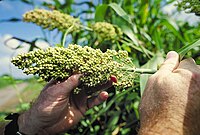
Photo from wikipedia
This study was conducted to determine if common buckwheat (Fagopyrum esculentum Moench) residues affect a phenolics composition in soil, and are effective for limiting emergence, growth and metabolic changes in… Click to show full abstract
This study was conducted to determine if common buckwheat (Fagopyrum esculentum Moench) residues affect a phenolics composition in soil, and are effective for limiting emergence, growth and metabolic changes in barnyard grass (Echinochloa crus-galli (L.) P. Beauv.), wild oat (Avena fatua L.), yellow foxtail (Setaria pumila Schult.), silky windgrass (Apera spica-venti L.), catchweed bedstraw (Galium aparine L.), scentless mayweed (Matricaria inodora L.), and tiny vetch (Vicia hirsuta L.). In the study, the residues of 14-day-old buckwheat plants were used (cv. Hruszowska). After removal of the above-ground parts, the buckwheat root residues (BRR) remained in the soil for an additional 7 days before the weeds were sown. For comparison, under the same cultivation conditions, the effect of entire buckwheat plant residues (BPR) in soil was assessed. BPR and BRR in the soil caused a decrease in the emergence of all weed species except the tiny vetch. The growth of barnyard grass, wild oat, yellow foxtail, catchweed bedstraw, and scentless mayweed was inhibited by BRR, but not BPR. BRR had a particularly strong inhibitory effect on the growth of scentless mayweed (SM) and catchweed bedstraw (CB). Thirty-day-old SM and CB control plants were about 4 and 3.5 times higher, respectively, than plants growing in the presence of BRR. Furthermore, chlorophyll and carotenoid contents in the barnyard grass and catchweed bedstraw were more prominently reduced by BRR than BPR. Stressful conditions caused by buckwheat residues in the soil increased the level of phenolic compounds in the tissues of weeds examined. Soil with buckwheat residues contained a low level of phenolic compounds, which may indicate their slow release from the residue or rapid utilisation by microorganisms. These phenolic compounds probably cannot be directly responsible for allelopathic inhibition of weed emergence and growth.
Journal Title: Acta Physiologiae Plantarum
Year Published: 2020
Link to full text (if available)
Share on Social Media: Sign Up to like & get
recommendations!